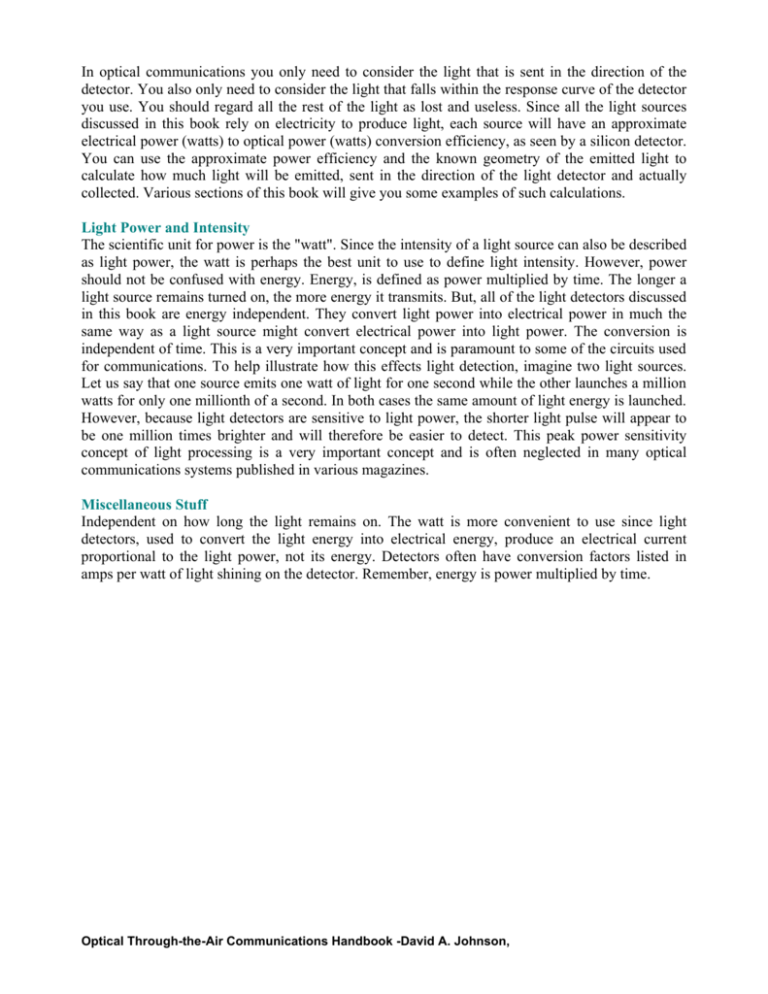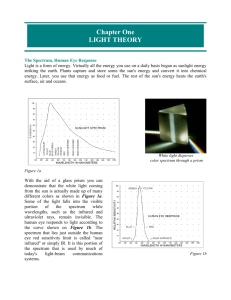In optical communications you only need to consider the light that is
advertisement

In optical communications you only need to consider the light that is sent in the direction of the detector. You also only need to consider the light that falls within the response curve of the detector you use. You should regard all the rest of the light as lost and useless. Since all the light sources discussed in this book rely on electricity to produce light, each source will have an approximate electrical power (watts) to optical power (watts) conversion efficiency, as seen by a silicon detector. You can use the approximate power efficiency and the known geometry of the emitted light to calculate how much light will be emitted, sent in the direction of the light detector and actually collected. Various sections of this book will give you some examples of such calculations. Light Power and Intensity The scientific unit for power is the "watt". Since the intensity of a light source can also be described as light power, the watt is perhaps the best unit to use to define light intensity. However, power should not be confused with energy. Energy, is defined as power multiplied by time. The longer a light source remains turned on, the more energy it transmits. But, all of the light detectors discussed in this book are energy independent. They convert light power into electrical power in much the same way as a light source might convert electrical power into light power. The conversion is independent of time. This is a very important concept and is paramount to some of the circuits used for communications. To help illustrate how this effects light detection, imagine two light sources. Let us say that one source emits one watt of light for one second while the other launches a million watts for only one millionth of a second. In both cases the same amount of light energy is launched. However, because light detectors are sensitive to light power, the shorter light pulse will appear to be one million times brighter and will therefore be easier to detect. This peak power sensitivity concept of light processing is a very important concept and is often neglected in many optical communications systems published in various magazines. Miscellaneous Stuff Independent on how long the light remains on. The watt is more convenient to use since light detectors, used to convert the light energy into electrical energy, produce an electrical current proportional to the light power, not its energy. Detectors often have conversion factors listed in amps per watt of light shining on the detector. Remember, energy is power multiplied by time. Optical Through-the-Air Communications Handbook -David A. Johnson, It isn't enough to say that a standard 100 watt bulb emits more light than a tiny 1 watt bulb. Sure, if you set a big 100 watt bulb next to a small 1 watt flashlight bulb, the 100 watt bulb would appear to emit more light. But there are many factors to consider when defining the brightness of a light source. Some factors refer to the nature of the emitted light and others to the nature of the detector being used to measure the light. For some light emitting devices, such as a standard tungsten incandescent light bulb, the light is projected outward in all directions (omni-directional). When visually compared to a bare 1 watt bulb, the light emitted from a bare 100 watt bulb would always appear brighter. However, if you were to position the tiny 1 watt bulb in front of a mirror, like a flashlight reflector, the light emerging from the 1 watt light assembly would appear much brighter than the bare 100 watt, if viewed at a distance of perhaps 100 feet. So, the way the light is projected outward from the source can influence the apparent brightness of the source. An extreme example of a highly directional light source is a laser. Some lasers, including many common visible red laser pointers, are so directional that the light beams launched spread out very little. The bright spot of light emitted might remain small even after traveling several hundred feet. The preferential treatment that a detector gives to some light wavelengths, over others, can also make some sources appear to be brighter than others. As an example, suppose you used a silicon light detector and compared the light from a 100 watt black-light lamp that emits invisible ultraviolet light, with a 100 watt tungsten bulb. At a distance of a few feet, the silicon detector would indicate a sizable amount of light being emitted from the light bulb but would detect very little from the black-light source, even though the ultraviolet light could cause skin burns within minutes. So which is brighter? In order to define how much light a source emits you first need to specify what wavelengths you wish to be considered. You must also assign a certain value to each of the considered wavelengths, based on the detector being used. In addition, since many light sources launch light in all directions you must also define the geometry of how the light is to be measured. Perhaps you only want to consider the amount of light that can be detected at some distance away. The wavelengths you may want to consider will depend on the instrument used to make the measurements. If the instrument is the human eye then you need to consider the visible wavelengths and you will need to weigh each of the wavelengths according to the human eye sensitivity curve. If the instrument were a silicon detector, then you would use its response curve. When doing research on light, you will come across many different units being used by various light manufacturers. All the units are trying to describe how much light their devices emit. You will see units such as candle power, foot candles, candelas, foot lamberts, lux, lumens and my favorite: watts per steradian. Some units refer to the energy of the light source and others to the power. Many units take only the human eye sensitivity into account. The light units can be even more confusing when you consider that some light sources, such as a common light bulb, launch light in all directions while others, such as a laser, concentrate the light into narrow beams. Rather than confuse you even more by going into a long discussion of what the various units mean, I'm going to try to simplify the problem. Let's just assume that each light source has a distinctive emission spectrum and a certain emission geometry. You will have to treat each light source differently, according to how it is used with a specific communications system. Optical Through-the-Air Communications Handbook -David A. Johnson, As can be seen from Figure 1a, sunlight is a very powerful source for this band of light, so are standard incandescent lamps and light from camera photoflash sources. However, many other manmade light emitters, such as fluorescent lamps and the yellow or blue/white street lamps, emit very little infrared light. Silicon Detector Response Just as our eyes are more sensitive to certain wavelengths so are some electronic light detectors. As shown in Figure 1c a typical silicon light detector has a response curve that ranges from the longer midinfrared wavelengths, through the visible portion of the spectrum and into the shorter and also invisible ultraviolet wavelengths. The most notable feature of the silicon detector's curve is its peak sensitivity at about 900 nanometers. Also note that at 600 nanometers, visible red, the silicon detector response is about one half that of its peak. It should therefore be Figure 1c clear that any light source with a 900 nanometer wavelength would have the best chance of being detected by the silicon detector. Fortunately, as we shall see in the section on light emitters, many of today's infrared light emitting diodes (LEDs) do indeed emit light at or near this 900nm peak. Units of Light As shown in Figure 1d a standard tungsten incandescent light bulb emits a very broad spectrum of light. If you took all the light wavelengths into consideration, including all those that were invisible to the human eye, the light bulb's electrical power to light power conversion efficiency would approach 100%. However, much of the light emitted from such a source takes the form of long infrared heat wavelengths. Although still considered light, heat wavelengths fall well outside the response curve of both our human eye and a silicon detector. If you only considered the visible portion of the Figure 1d spectrum, the light bulb's efficiency would only be about 10%. But, to a detector that was sensitive to heat wavelengths, the bulb's efficiency would appear to be closer to 90%. This takes us to one of the most confusing areas of science. How do you define the brightness or intensity of a light source? Optical Through-the-Air Communications Handbook -David A. Johnson, Chapter One LIGHT THEORY The Spectrum, Human Eye Response Light is a form of energy. Virtually all the energy you use on a daily basis began as sunlight energy striking the earth. Plants capture and store some the sun's energy and convert it into chemical energy. Later, you use that energy as food or fuel. The rest of the sun's energy heats the earth's surface, air and oceans. White light disperses color spectrum through a prism Figure 1a With the aid of a glass prism you can demonstrate that the white light coming from the sun is actually made up of many different colors as shown in Figure 1a. Some of the light falls into the visible portion of the spectrum while wavelengths, such as the infrared and ultraviolet rays, remain invisible. The human eye responds to light according to the curve shown on Figure 1b. The spectrum that lies just outside the human eye red sensitivity limit is called "near infrared" or simply IR. It is this portion of the spectrum that is used by much of today's light-beam communications systems. Figure 1b






